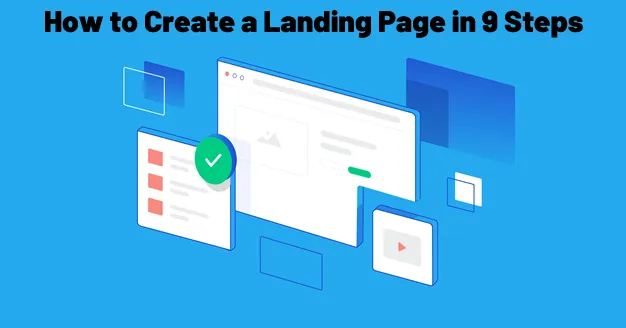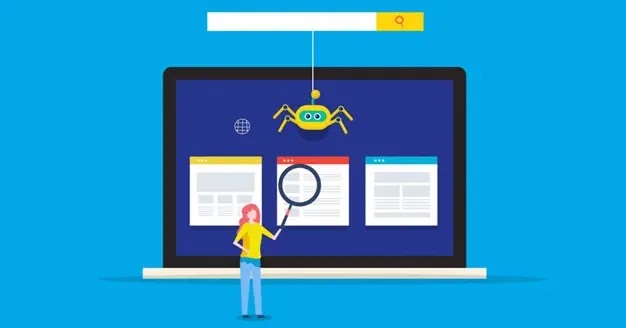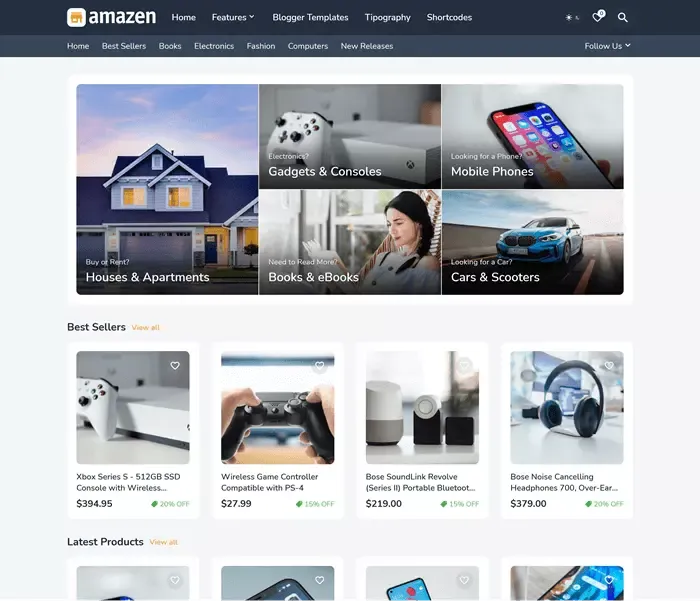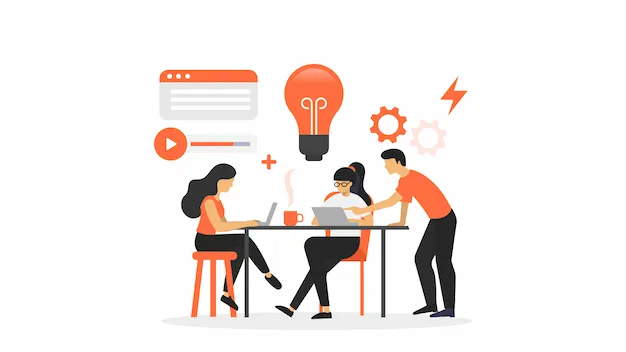How to Create a Landing Page in 9 Steps
How to create a landing page - is a question that every internet marketer faces when launching a significant advertising campaign because a landing page is an independent web page designed with a specific goal in mind.
Its purpose is to interest visitors in the offer of products/services and bring them closer to the purchase or registration process.
The more landing pages you have, the better. A recent study by HubSpot showed that marketers who make 55% more sales have about 10-15 landing pages.{alertInfo}
Landing pages have become part of everyday
marketing, especially when it comes to building an email list.
Why should you use Landing Pages?
- With Landing pages, the focus is on conversion.
For the landing page to be able to convert visitors into subscribers,
customers, and collaborators and get them to take a specific action, you need
to have direct access to:
- Highlight the question you are solving.
- Explain how this issue is resolved.
- Consider all potential objections and questions, and overcome them.
- Create an offer.
- You can test the landing page using A/B Split Test.
For instance, you may compare the page's titles (one in variant A and
the other in variant B) to see which is more engaging to visitors. Every
successful subscriber is a conversion when your page has an offer to sign up
and get an e-book. It's known as your CTA.
- You can create multiple different page versions for various ads.
Compared to
blog posts
landing pages can be more precisely targeted. When running a paid ad, you can
be very specific in targeting your audience.
Instead of using one
target group that you lead to one landing page, you can create several:
different ads, target groups, and landing pages, so that the landing pages are
adapted; to locations, interests, and problems that your offer solves.
This
way, you will achieve higher conversion rates for each page.
- You can remove distracting factors from the Landing page.
To understand this, we can compare the Landing page with any page on
your blog.
While reading the main text - attention is drawn to the
sidebar with the latest articles, various links, and the footer of the blog,
each of which can lead the reader to another page, so that he does not take
any action.
That is why the landing page directs each visitor to a
specific action and removes any form of communication that is not directly
related to the offer.
- You can create different landing pages to be found in search engines.
Targeting specific keywords is essential to improve landing pages for
search engines. Here you can use keywords in the URL address, title, and body
of the page. It is best applied when targeting one keyword for one landing
page.
Visitors come to the landing page after clicking on a link in
a PPC campaign ad, on social networks, in an email, on a banner, and the like.
Landing pages are very important and are intended for visitors who are looking
for something specific, so the elements they consist of are particularly
essential.
Landing page goals and elements
The goal of the landing page is to collect information about visitors,
which will enable you to connect with them and build a relationship of trust
in the coming period.
That is why, before clicking on the
call-to-action (CTA) button and being redirected to the thank-you page (where
they will receive the promised gift) - visitors leave their information (most
often name and email address) by filling out the Opt-in form because they
expect to take over something that will be valuable to them.
When
it comes to the opt-in form, it's best to keep it simple. In the part of the
form, emphasize why visitors should click on the button and take action. This
button should be distinguished by its color from the rest of the page (for
example, orange evokes positive feelings).
The call to action (CTA)
is the most significant part of the page because it is also the reason why
they are on your page, so it should be clear: "To download the ebook, please
fill out the form on the right."
By clicking on the CTA button, the
user receives information about receiving the gift in his email. In this way,
the user also becomes part of your email list, so email marketing is an
inseparable part of the functioning of landing pages.
For the CTA
button, you can choose your brand colors or use one of the tools for colors
and the best shades, such as
Paletton. An example of a good CTA is in the picture below:
The length of the Opt-in form (the maximum number of fields is 7), i.e. the amount of requested data, can directly affect the conversion rate (avoid asking for a phone number).
With the form, it is essential to emphasize the note that the data left by the visitors are safe and that you will not pass it on to third parties (so that the visitors know that they are in good hands and are happy to download the content).
What is offered in exchange for visitor data are:
- ebook, webinar registration,
- discount coupons, subscription to the newsletter,
- professional consultations, online courses, videos,
- a physical gift that is sent to an address,
- information about the product/service in the upcoming period,
- presentation, report or study,
- free period of using a service.
On the landing page, it is important to present a brief overview of the
offer and explain the real benefit of what you offer for the end-user.
It
should be clear and easy to understand. Try to answer the question:
"What will it do for me, and how will it help me?"
You can present all the benefits that solve a specific problem by
item, avoiding long text. Here you do not deal with the characteristics of
what you offer for visitors to download, for example, an ebook.
The
title of the landing page is what a potential customer sees first. Avoid
unnecessary words and say what you have to offer because you only have six
seconds to grab their attention and make them read on.
For the
title and text on the landing page, use keywords related to your
product/service.
Choose an image with your brand, company, product,
or service that you want to sell. If you add a video with an explanation
instead of an image you can increase conversions by up to 86%.
Place
icons for social networks at the top or bottom of the page and allow the page
to be shared on those networks.
Provide relevant experiences
related to your product or service because people want to see and hear that
before making a purchase. All experiences should be directly related to what
you are promoting.
You can put logos and names of companies that
use your products or services. If you don't have testimonials, you can also
use comments from Facebook and Twitter.
It is very important to
test the landing page, especially if you are spending money on campaigns. A
good way would be to create two landing pages and change some elements on one,
depending on what you want to test: the text of the call to action, the color
and size of the button, the title,
image, text font, etc.
It's
called split testing, and it's how you find out the cause of good or bad
results. The only way to improve your conversions is to monitor what you are
doing, how you are doing it, and what needs to be changed.
Using
Google Analytics, you can monitor your landing page by the total number of
visitors, number of new visitors, bounce rate, conversion rate, duration of
page visits, number of purchases, etc.
If your landing page is not
mobile-friendly - it is not visible on mobile devices, you will lose a lot of
visitors.
When designing a landing page, there are key elements that need to be
considered for the call to action to be successful and convert visitors into
customers.
Before starting to design a landing page (by yourself or
with a designer), it is best to draw your idea on paper and remember a few
more things:
- Keep in mind the problems, needs, and wants of your target audience. When you write the text for the page, think of these people.
- Define the action you would most like visitors to take.
If you sell cheaper products, then direct selling makes sense. When it
comes to a service or software, it is best to refer them to a trial period.
In
case you have a complex and expensive product, then it is best to ask for an
email address and start building a relationship with subscribers.
- Write your text message that will present the problem and the solution you offer easily and understandably. You can do this in several copies that can help you when testing what works best for visitors.
Now that you understand the audience, the problem, and the solution, you
can start designing the landing page with the help of the infographic I
prepared for you.
The
infographic
will provide you with all the information you need. For an enlarged view
infographic, click on the image.
Share this Image On Your Site
Design and optimization of a landing page that will have a high rate of
conversion is not an easy task. Effective landing pages contain creative
headlines and prominent calls to action. Use the tools to create attractive
headlines.
To achieve the goal - it is enough to understand all the
elements of the landing page that attract attention. After that, it's
important to provide your visitors with all the information you promised
them.
I believe this article and infographic will help you
accomplish your task.
If you found something valuable for yourself
in this article, please like and share it on Facebook and Twitter so that it
can help others.
Thanks for reading :)









